User experience (UX) is no longer a nice-to-have. It’s deciding between a product that’s adopted and one that’s left behind. Today's best brands create experiences that feel real, effortless, intuitive, and aligned with user needs. And that’s where top UX design agencies come in.
To help you decide about your options, we’ve listed the top UX design agencies in 2025. The selection comes from decades of experience in branding and product work, alongside verified client reviews from Clutch, agency portfolios, and other publicly available data. You’ll see each design firm’s approach, specialties, and relevance for different industries or company stages.
But before we dive into the list, let’s unpack why these agencies matter in the first place and what hiring one can do for your business.
Our UX Agency Evaluation System: Proving the Ratings
Choosing the right partner agency can be the difference between a product that performs and one that falls flat. We’ve reviewed dozens of agencies based on their portfolio strength, client feedback, design services, and impact across industries.
To ensure our ranking goes beyond subjective opinion and provides a truly useful competitive analysis, we developed a structured evaluation system based on the four most critical factors a business considers when hiring a top UX design agency. This system is grounded in our decade of operational experience in the industry and serves as the foundation for the radar chart visualization.
Defining the Core Dimensions
We score each agency on a 1 to 5 scale (1 being the lowest/least, 5 highest/most) across four dimensions, proving our expertise by focusing on practical, high-value metrics:
| Dimension | Why It Matters |
|---|---|
| Depth of Research | The commitment to evidence. High scores mean dedicated UX researchers, field studies, and data-driven discovery, not just standard usability testing. |
| Implementation | The ability to deliver. High scores mean the agency integrates design, product strategy, and often in-house engineering capabilities for a complete solution. |
| Project Speed / Velocity | The efficiency of delivery. High scores indicate rapid iteration cycles, lean processes, and specialized models for fast time-to-market. |
| Price / Cost Index | Transparency on investment level. High scores indicate premium global consultancy rates (typically $300+/hr); low scores indicate specialized subscription or boutique rates. |
Our scores are not arbitrary. To maintain trustworthiness and authoritativeness, we synthesize data from three verifiable sources:
- Portfolio Analysis: We review each agency's public case studies, specifically looking for quantitative results (e.g., "increased conversion by X%") and evidence of their process (e.g., presence of research artifacts, prototypes).
- Third-Party Validation: We cross-reference claims with established industry review platforms like Clutch and G2, focusing on client reviews that mention project timeline, pricing expectations, and delivery quality.
- Industry Positioning: Our internal experience is used to assign scores based on the agency's widely recognized business model (e.g., an agency known for large conceptual innovation gets a high score in Research but a low score in Speed).
With this transparent methodology, we ensure that our comparison method is a reliable, evidence-backed resource that you can trust to inform your vendor selection.
Top UX Design Agencies - November 2025
1. Ramotion
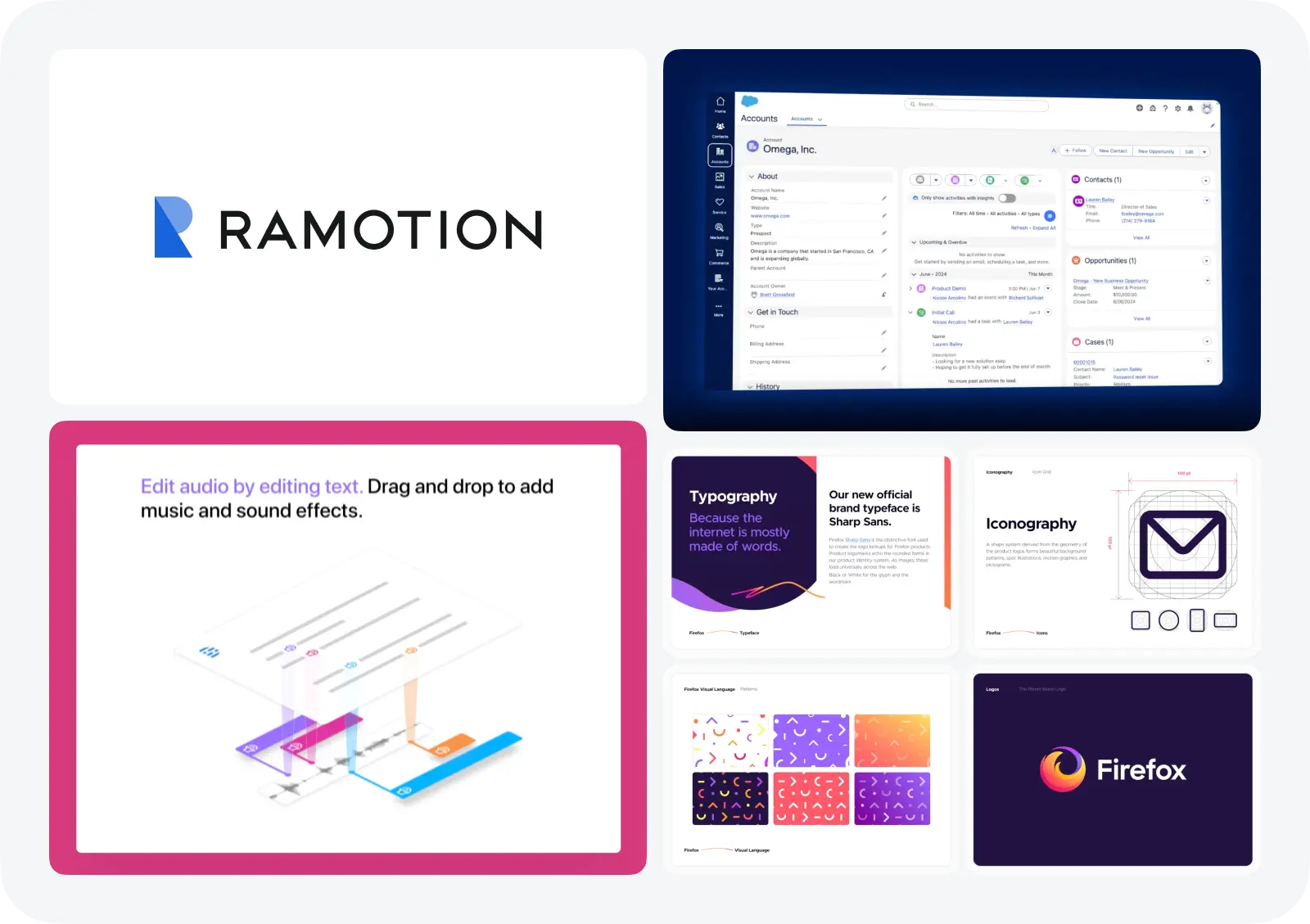
- Best for: Mid-to-large tech companies and startups that require a high-fidelity blend of UI/UX execution and visual brand identity with a clear roadmap for developers.
- Downside: While they emphasize strategy, their core strength is execution. Large-scale, purely conceptual or organizational design thinking projects may be better suited for larger consultancies.
- Portfolio: Highlights strong visual execution and detailed product development across various platforms, demonstrating their focus on transforming strategies into visually stunning and functional interfaces.
- Strengths: Seamless documentation & handover (providing detailed specifications, style guides, and assets). Strong UI/visual design execution. Focus on boosting conversions and engagement.
- Unique offerings: Offers post-launch support to monitor performance and recommend iterative updates, showing a commitment to long-term product evolution beyond the initial release.
Ramotion is a boutique UX design agency based in San Francisco, uniting brand identity, user experience, and front-end development under one roof. Ramotion specializes in helping high-growth startups and tech-forward businesses build digital products that feel as good as they look. With a team that blends visual design and functional strategy, the work spans mobile apps, websites, and complex platform interfaces: all created to elevate the customer experience.
Rather than juggling dozens of accounts, Ramotion takes on fewer design projects to stay fully engaged with its clients. This collaborative approach helps better influence product direction early and improve details at scale. Brands like Mozilla, Salesforce, and Descript have trusted these UX design services.
| Location(s) | San Francisco (CA, USA) |
| Founded | 2009 |
| Team Size | 10–49 |
| Clients | Startups, SMBs |
| Services | Branding, UI/UX Design, Web Development, Mobile Apps |
| Budgets | $50,000+ |
| Industries | Technology, Education, Finance, Healthcare |
2. IDEO

- Best for: Organizations facing complex, ambiguous challenges (business, social, or product) that require upstream strategy, deep human insight, and organizational change through design thinking.
- Downside: Less focused on final UI/UX execution and code delivery, also can be perceived as conceptual or high-level, and is extremely expensive.
- Portfolio: Focuses on innovation breakthroughs and applying design thinking to areas like healthcare, education, and retail—not solely digital interfaces.
- Strengths: The original authority on design thinking. Ability to balance desirability, feasibility, viability, and responsibility. Has multidisciplinary, conceptual strategy.
- Unique offerings: IDEO U (training and education on Design Thinking). Application of design methodology to non-digital problems (systems, services, and organizational culture).
IDEO is a pioneer of human-centered design. With decades of experience and offices worldwide (USA, UK, and China), IDEO partners with organizations to explore the deeper needs behind digital challenges. Their UX work focuses on immersive research, storytelling, and breakthrough innovation.
Clients turn to IDEO to rethink the interface and the whole product system. Their design process isn’t always fast, but it’s rigorous and perfect for complex problems in healthcare, education, and mobility. IDEO is a benchmark UX design firm for businesses looking to invest in meaningful, long-term design outcomes.
| Location(s) | San Francisco (CA, USA) |
| Founded | 1991 |
| Team Size | 500+ |
| Clients | SMBs, Enterprise |
| Services | Branding, Design Strategy, UI/UX Design, Web Development |
| Budgets | $50,000+ |
| Industries | Greentech, Hospitality, Consumer Products, Health |
3. Work & Co
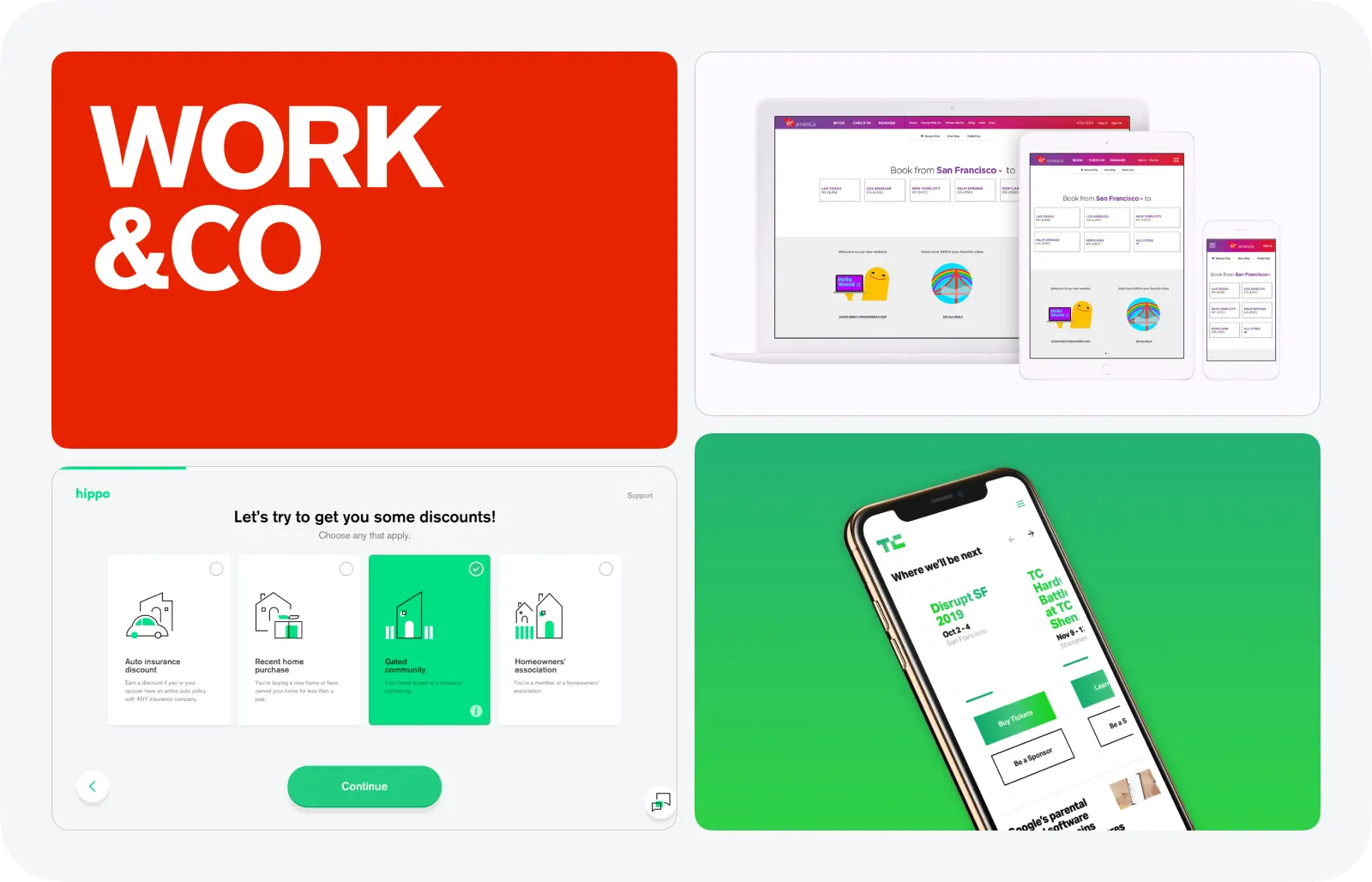
- Best for: Global brands and large enterprises (e.g., Apple, IKEA, Disney, Gatorade) needing end-to-end digital product strategy, design, and high-velocity engineering and launch.
- Downside: High-tier rates and project minimums. Also generally focused on massive-scale transformation rather than small, focused feature updates.
- Portfolio: Features iconic, global digital transformation projects, including omnichannel commerce, custom apps, and large platform redesigns with measurable results.
- Strengths: Full digital product lifecycle delivery (strategy, design, development). Proven track record with F500 and influential brands. Focus on launching tangible products quickly.
- Unique offerings: Partner-led engagements and a reputation for high-velocity, hands-on product launching that transforms client business lines.
Work & Co is a global UX design company known for crafting digital products for brands like IKEA, Apple, and Google. Their process is based on integrating design, strategy, and technology from day one and creating future-proof solutions that scale. With a smaller team structure, clients work directly with the designers and developers building the product.
Work & Co. emphasizes rapid prototyping and real-time iteration, ensuring everything from the first wireframe to the final launch is centered on user behavior. They’re among the top UX design firms working today for enterprise level challenges where functionality must match form. They don’t just polish interfaces, they help define the whole digital experience.
| Location(s) | Brooklyn (NY, USA), Portland (OR, USA), São Paulo (Brazil) |
| Founded | 2013 |
| Team Size | 250–999 |
| Clients | SMBs, Enterprise |
| Services | Product Design, Web Concept, UX/UI Design |
| Budgets | $50,000+ |
| Industries | Consumer Products, Sports, Entertainment, Technology |
4. Metalab

- Best for: High-growth startups and established tech leaders (e.g., Slack, Uber, Coinbase) seeking world-class visual and interaction design combined with integrated engineering services.
- Downside: Very high price point. reputation is heavily skewed toward premium interface design, making it less accessible for smaller or non-tech focused businesses.
- Portfolio: Known for designing the original interfaces for iconic products (e.g., Slack's early product, original AI platform interfaces). Demonstrates strong balance of UX, visual design, and engineering.
- Strengths: Exceptional UI/Visual execution and polishing. Capability for integrated product strategy, design, and engineering; proven ability to scale with market-defining tech companies.
- Unique offerings: End-to-end digital product shop offering R&D and custom interfaces for new technologies (like AI platforms), positioning them at the forefront of product design trends.
Metalab is a Canada-based UX design company known for shaping digital tools for some of the biggest brands in tech, including Slack and Coinbase. Their work balances thoughtful design with high functionality, serving smaller and enterprise teams alike. From product strategy to visual design, Metalab helps teams turn early concepts into polished, scalable digital products.
Their ability to unify UI design, product logic, and technical execution makes them a standout partner—especially when your app or platform must be beautiful and usable.
| Location(s) | Victoria (BC, Canada) |
| Founded | 2006 |
| Team Size | 10-49 |
| Clients | SMBs, Enterprise |
| Services | Web Design, UI Library, Motion Frameworks, UX Design |
| Budgets | $50,000+ |
| Industries | Technology, Educational, Clothing, Healthcare |
5. UX Studio

- Best for: Complex SaaS platforms, B2B companies, and enterprise products that require a dedicated, research-first partner focused on long-term product evolution and measurable UX KPIs.
- Downside: They are a design-only specialist. They do not offer in-house development/coding services, requiring the client to have an existing internal or external development team for implementation.
- Portfolio: Features case studies focused on improving user retention, conversion, and workflow efficiency for complex, high-stakes products. Known for work with verifiable global brands like Netflix and The United Nations WFP.
- Strengths: Deep UX research focus (often utilizing dedicated UX researchers, not just designers). Structured, adaptable process (e.g., they often use an embedded team model). Strong expertise in SaaS/B2B verticals.
- Unique offerings: Offers flexible, scalable embedded design teams that integrate directly into the client's product team structure. Strong focus on product discovery workshops and fast, evidence-based iteration.
Budapest-based UX Studio specializes in experience design backed by research. With clients like HBO and UNICEF, it operates as a UX agency that blends scientific rigor with practical delivery. Their teams investigate user needs through interviews, usability testing, and analytics before moving into UI design and prototyping.
UX Studio often acts as an embedded partner, collaborating with startups, SMBs, and enterprise companies in many industries. Their focus on product-led growth makes them a smart pick for digital teams who want research-driven design decisions, not just visual polish. If you aim to create products people want to use, they’re worth your shortlist.
| Location(s) | Budapest, Hungary |
| Founded | 2013 |
| Team Size | 50–249 |
| Clients | Enterprise, SMBs |
| Services | UI/UX Design, Product Design, Web Design |
| Budgets | $10,000+ |
| Industries | Medical. Business Services, Financial, Hospitality |
6. Neuron

- Best for: B2B software, enterprise tools, and complex SaaS products that need deep expertise in tackling usability, information architecture, and complex workflows.
- Downside: Less focused on consumer-facing projects or experimental visual design. Their strength is in functional, logical, and usable business applications.
- Portfolio: Features client stories centered on improving productivity, sales, and intelligence for B2B/Enterprise clients, demonstrating success in solving complex workplace challenges.
- Strengths: Deep B2B/Enterprise domain expertise. Strong focus on product blueprinting (full specifications) for smooth implementation. Strategic and tactical UX/UI work.
- Unique offerings: The "Product Blueprint", a full set of specifications and interaction models for developers, ensuring accuracy and setting the client up for long-term development success.
Neuron is a San Francisco-based UX agency focused on building intuitive digital products, particularly for enterprise and B2B markets. Their clients range from Harvard to Ford Models, and they specialize in simplifying complex user flows and improving interface usability across digital tools.
Their design process includes discovery, heuristics, journey mapping, and prototyping: all aimed at reducing friction in high-stakes environments. Neuron isn’t flashy. Instead, they’re methodical, making them a strong UX design partner for workplace tools, dashboards, or apps that involve a lot of information.
| Location(s) | San Francisco (CA), Los Angeles (CA), Boston (MA, USA) |
| Founded | 2016 |
| Team Size | 10–49 |
| Clients | SMBs |
| Services | UX Strategy, User Research, Usability Testing |
| Budgets | $25,000+ |
| Industries | Consumer Products, Education, Finance, Real Estate |
7. Beyond
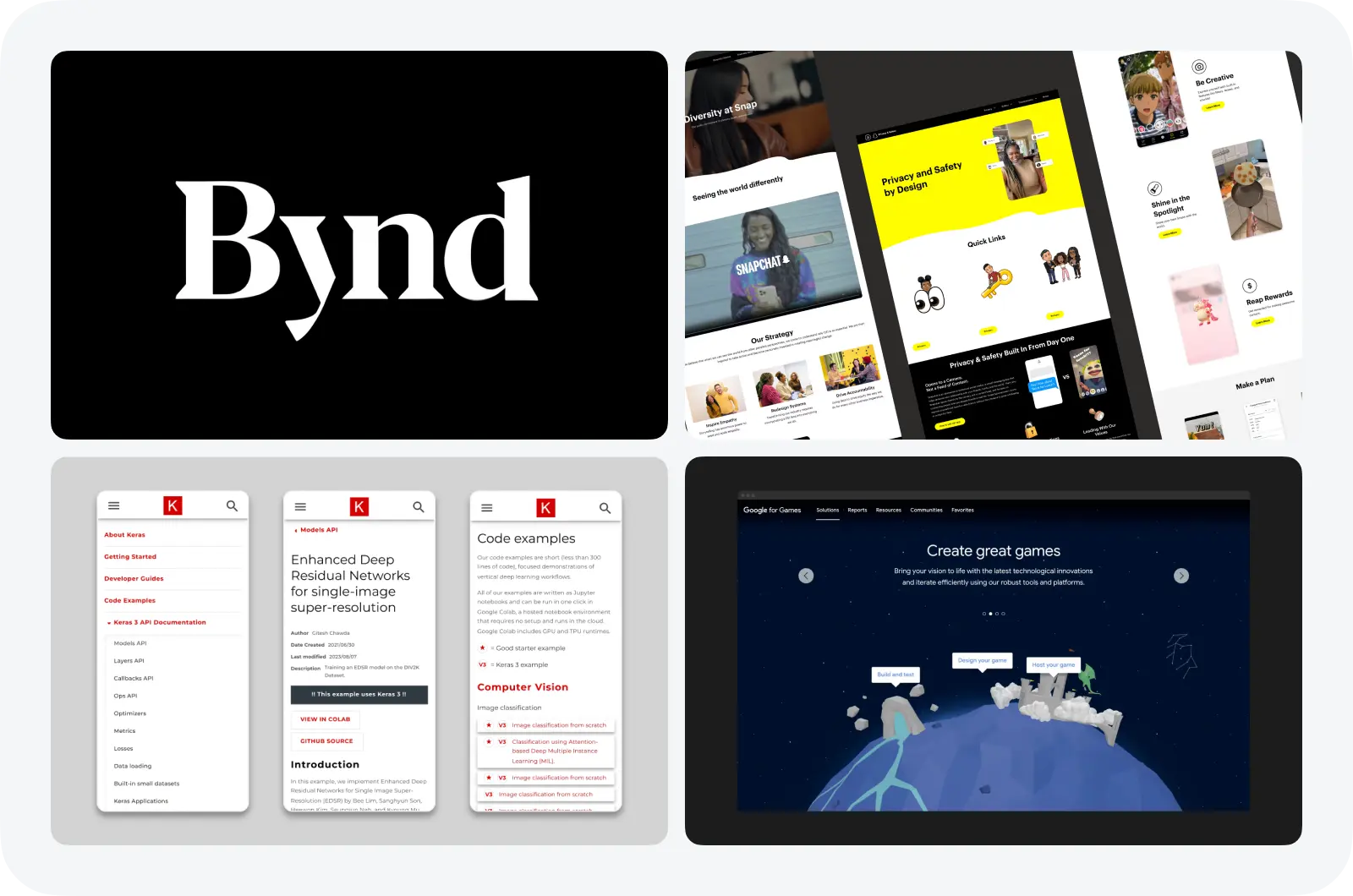
- Best for: Large enterprises that need a partner to move "Beyond Digital", focusing on strategic transformation and building differentiating capabilities through technology and ecosystem integration.
- Downside: The broad, strategic focus means they are not a pure-play, affordable UX/UI execution shop. Projects are high-level, business-critical, and long-term.
- Portfolio: Tied to larger strategic consulting/transformation work, focusing on capability building and aligning digital initiatives with long-term growth rather than incremental optimization.
- Strengths: Strategic depth in linking digital projects to organizational capabilities and business models. Focus on outcome-oriented execution and value creation via ecosystems.
- Unique offerings: Focus on the "Beyond Digital" concept—helping companies redefine their purpose, build differentiating capabilities, and leverage AI/ecosystems for competitive advantage.
Beyond is a design and technology agency with offices in London and the US. It works with global clients like Facebook and Mailchimp. Beyond focuses on building digital experiences that connect design, data, and development. Its UX approach is deeply rooted in research and experimentation, often kicking off with stakeholder workshops and interactive prototypes.
Beyond excels at bridging the design-development divide. It pulls in its UX designers and engineers early in the process, reducing gaps and speeding up delivery. Beyond offers a future-proof UX design agency model that scales well across time zones for brands tackling complex systems (especially those with global reach or multi-platform ecosystems).
| Location(s) | San Francisco (CA, USA), New York City (NY, USA), London (UK) |
| Founded | 2010 |
| Team Size | 50–249 |
| Clients | Enterprise |
| Services | Digital Strategy, Branding, Product Design, AR/VR |
| Budgets | $75,000+ |
| Industries | Information Tech, Media, Retail, Finance |
8. Red Antler
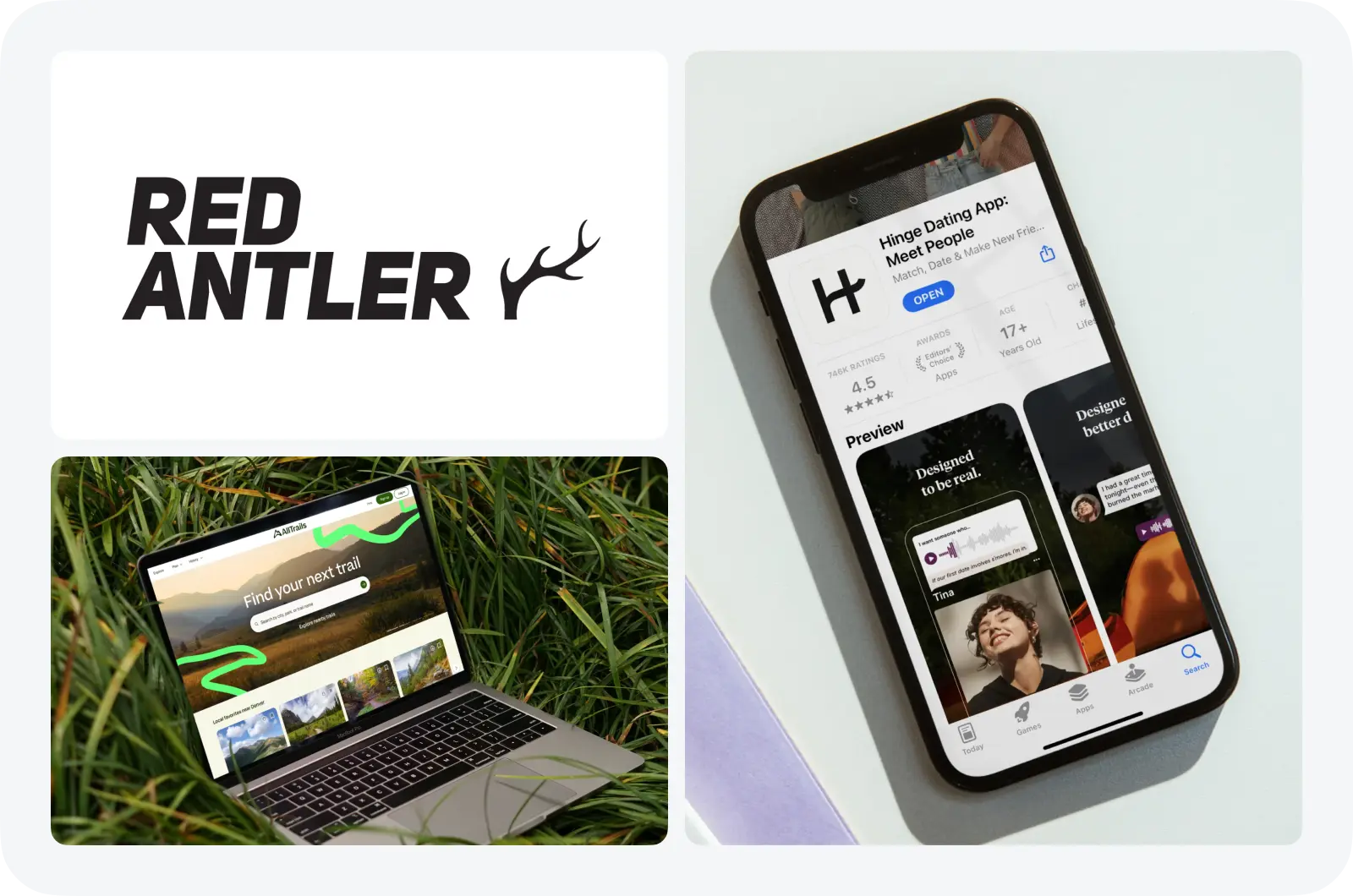
- Best for: High-growth startups, new consumer ventures, and DTC brands (e.g., Chime, Hinge) needing a full brand, strategy, and digital launch partner.
- Downside: Their UX/UI work is often in service of the brand strategy. They are not the best choice if the only need is a technical UX audit or an isolated feature design.
- Portfolio: Known for launching and transforming some of the world's fastest-growing consumer brands, with a strong emphasis on cohesive brand identity, strategy, and narrative.
- Strengths: World-class brand strategy. Exceptional ability to create a clear, high-impact go-to-market narrative. Highly valued by venture-backed companies.
- Unique offerings: Provides integrated brand & digital experience services tailored to the startup/launch lifecycle, ensuring the product and the brand are perfectly aligned from day one.
Red Antler is a Brooklyn-based branding and UX design firm that’s helped launch standout brands like Casper and Allbirds. They specialize in creating digital experiences that feel as intentional as the brand identity behind them. From websites to mobile apps, Red Antler makes sure that every interaction reinforces the story.
Their strength lies in mixing storytelling with UX. Red Antler has a sharp edge for early-stage companies looking to align design and growth, especially in consumer products and ecommerce. If you're launching something new and want your digital product to convert from day one, this is a UX design agency that gets it right.
| Location(s) | Brooklyn (NY, USA) |
| Founded | 2007 |
| Team Size | 50–249 |
| Clients | SMBs, Enterprise |
| Services | Advertising, Branding, Digital Strategy, Web Design |
| Budgets | $10,000+ |
| Industries | Technology, Education, Finance, Healthcare |
9. Duck.design
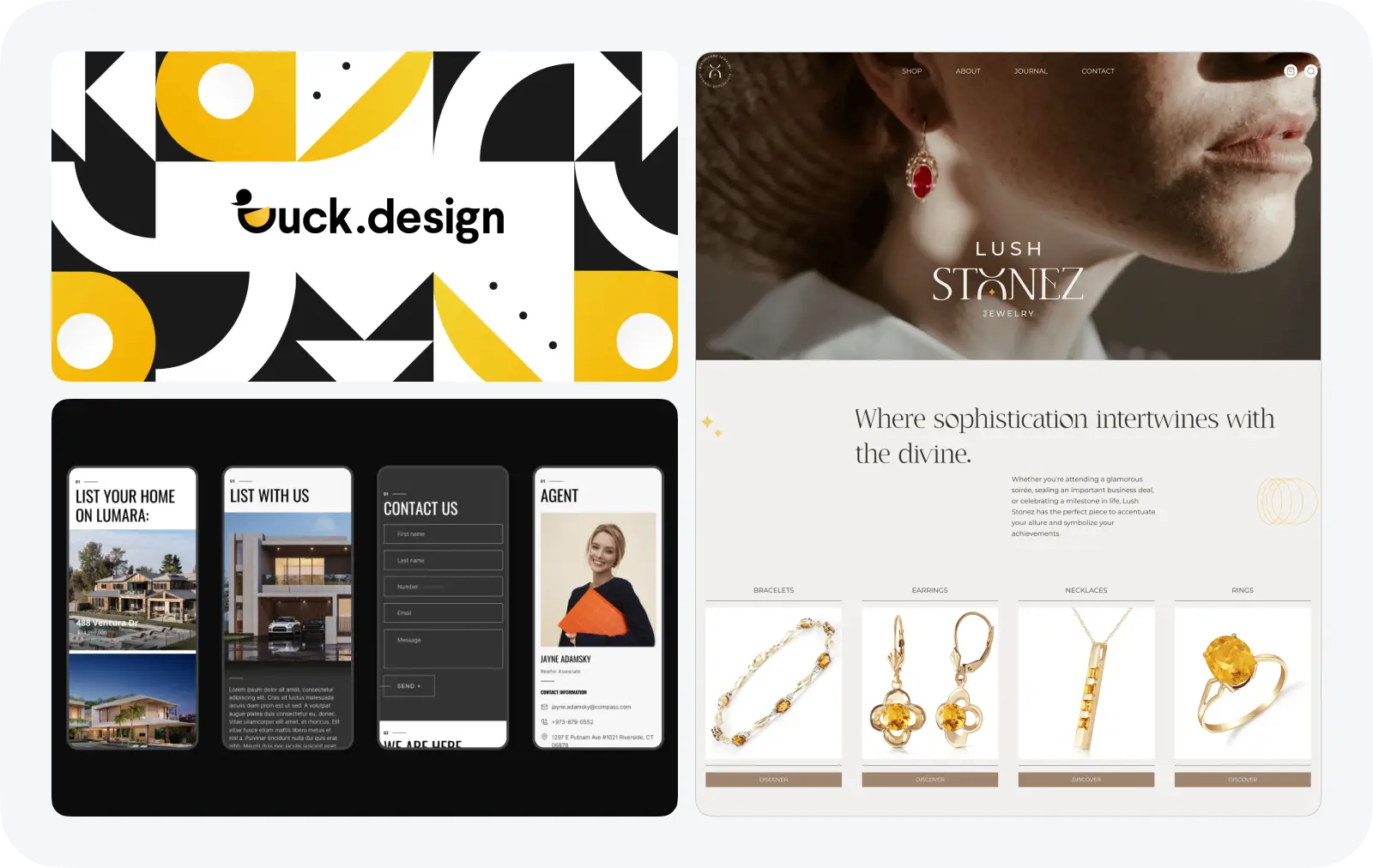
- Best for: Marketing teams, agencies, and SMBs/startups requiring a high volume of diverse design assets (graphic design, UI/UX, motion) quickly and affordably via a subscription model.
- Downside: Limited depth for complex UX research or strategic discovery. The model favors speed and quantity of output rather than long, bespoke strategic engagements.
- Portfolio: Features a wide array of work, including graphics, social media assets, landing pages, and UI/UX designs, reflecting their ability to handle diverse daily design needs.
- Strengths: Flat-rate, subscription model. Unlimited requests and revisions. Very fast turnaround (same-day delivery in some tiers). Dedicated designer/art director pairing.
- Unique offerings: The core subscription-based design service (graphic + UX/UI + motion) for a predictable monthly cost, functioning as an outsourced in-house design team.
Duck.design is a subscription-based UX agency offering unlimited design requests for a flat monthly rate. Their model is ideal for marketing teams and startups needing consistent execution across user interfaces, web design, and visual assets — without the overhead of hiring in-house. Their work is quick, structured, and focused on delivering user-friendly results fast.
They may not go deep into strategy or design thinking, but what Duck.design does well is deliver. With a dedicated design team and project manager, they help you keep momentum across design services, especially when tight deadlines are part of the brief. It’s a strong fit for teams that know what they want and need it done yesterday.
| Location(s) | London (UK), New York City (NY, USA) |
| Founded | 2017 |
| Team Size | 50–249 |
| Clients | Startups, SMBs |
| Services | Graphic Design, Branding, UX/UI Designs |
| Budgets | $1,000+ |
| Industries | Advertising, Arts, Education, Consumer Products |
What Is a UX Design Agency (And Why Do They Matter)?
A UX design agency specializes in creating digital experiences that are easy to use, accessible, and tailored to real human behavior. Their work is as much about how things look as it is about how they work. From mobile apps and websites to enterprise tools and eCommerce platforms, a UX design agency turns complexity into clarity.
Their services typically include UX research, user interface (UI) design, wireframing, usability testing, prototyping, and interaction design. Some agencies also offer complementary design services such as product strategy, visual design, or even branding, helping to bridge the gap between how something functions and feels.
But the value of UX design is more than process — it’s performance. Companies that prioritize UX and design as core business functions outperform their peers. Studies have shown that design-forward companies increase their revenue growth by 32% and shareholder returns by 56% in five years. That’s not a lift — it’s a transformation.
Conversion rates tell the same story. A user-friendly interface can lead to a 200% higher visit-to-order rate. UX design can increase conversions by up to 400%. This data makes a strong argument: UX isn’t a cost center. It’s a growth engine.
That’s especially true for brands working with several platforms or in multiple time zones. Consistency, clarity, and simplicity become critical when digital products span global teams and customer bases. A good UX design company helps ensure that those moving parts come together.
Conclusion
The comparison highlights clear variations in research depth, implementation quality, project speed, and pricing across leading UX design firms. Agencies with strong research and implementation capabilities tend to offer higher-quality outcomes but at a premium price, while those with faster delivery often trade off depth and strategic rigor.
Data provided by our selection methodology suggests a consistent balance between quality, speed, and cost, underscoring that selecting the right partner depends primarily on whether the project prioritizes innovation depth, execution excellence, or rapid turnaround.
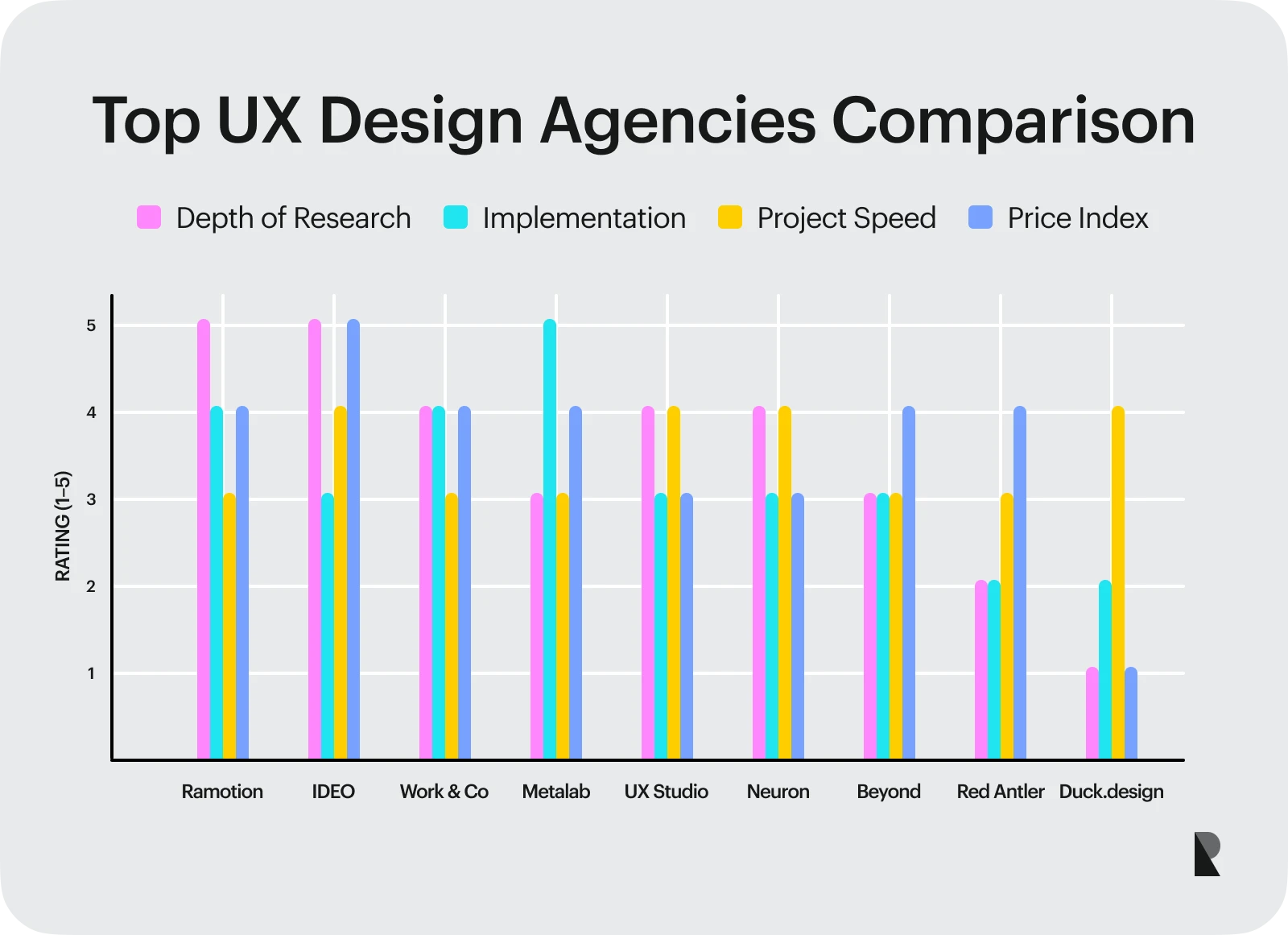
Each agency on this list brings an exceptional strength to the table. The key is matching their capabilities to your needs. Are you building from scratch? Redesigning something complex? Or scaling across multiple platforms and time zones? Whatever the case, a UX design company here can help you move forward and stay ahead.
If unsure where to begin, consider contacting a few agencies for a discovery call. The best partnerships start with honest conversations and the right UX agency won’t just execute. They’ll ask the right questions, challenge your assumptions, and build something better with you. And if you're looking for an agency that understands not just digital, but brand, you’re already in the right place. Explore our services here.
-
What are red flags when hiring an UX deisgn agency?
Be cautious if an agency speaks only about visuals and interface elements without connecting UX to measurable business goals. Lack of clarity about research methods, team composition, or design process is another concern.
Portfolios that showcase attractive screens without explaining user problems or outcomes suggest superficial work. A rigid approach indicates low maturity in UX thinking. If the agency does not ask in-depth questions about users, data, and context during discovery, the partnership will likely fail to deliver strategic value.
-
What does a UX design agency do?
A UX design agency defines how users experience digital products and services. Its work includes user research, journey mapping, information architecture, interaction and interface design, prototyping, and usability testing. The goal is to create products that are functional, aesthetically consistent, intuitive, efficient, and aligned with the client’s business strategy.
-
How long does a UX project last?
Most UX projects take 6 to 16 weeks. A basic website or app may take just over a month, while complex platforms can run longer. Many top UX design agencies offer phased engagements so you can start small and scale.
-
How do I choose the right agency for my project?
Clarify your goals, then match them to an agency’s strengths. Review case studies, ask for references, and look for a team that understands your industry — and challenges your thinking in the right way.
-
Can I continue working with the agency after the project is completed?
Yes. Many agencies offer ongoing support through retainers, optimization, or design systems — helping you maintain quality long after launch.
-
What if I already have a designer? Why an agency?
A UX agency brings outside perspective, deeper expertise, and more speed. They’re a strong complement to in-house teams — not a replacement — especially when stakes are high or timelines are tight.
-
Does the agency need access to my analytics and data?
Yes. Usage data, traffic, and conversion metrics help agencies make smarter design choices. Reputable teams will always treat your data securely and responsibly.
-
What is the typical budget for a strategic UX project?
Budgets vary widely. Expect $40k–$80k for a small, focused project with a specialist studio, and $150k+ for complex, enterprise-level transformations or full-service agencies.
-
How should I evaluate an agency's portfolio?
Focus on measurable outcomes, not just aesthetics. Look for case studies that detail the problem solved and provide specific business KPIs (e.g., conversion, retention, or efficiency gains).
-
What's the most important factor in a contract?
Ensure the contract explicitly guarantees that your company retains 100% of the Intellectual Property (IP), including all raw source files and design system assets, upon final payment.
-
Should I choose a design-only specialist or a full-service firm?
Choose a design-only specialist (strong in research/strategy) if you have an internal development team. Choose a full-service firm (design + code) if you need a single vendor for the entire build.
-
How should an agency handle scope changes?
A professional agency will have a formal Change Request (CR) process documented upfront. They must provide a transparent estimate of the cost and timeline impact before accepting new work.
-
How do I ensure a smooth developer hand-off?
Require the agency to deliver a design system and comprehensive specifications (often called a "Product Blueprint") to ensure developers can implement the design without guesswork.
-
What's the ideal team structure for a strategic project?
Look for a team that includes a dedicated UX Researcher alongside the designers, ideally at a ratio of 1 researcher to every 2–3 designers, to ensure the work is evidence-based.
May 15, 2025
